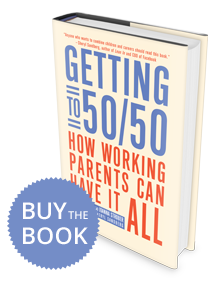50/50 Fact Sheet
Below are just a few of the eye-opening facts discussed in Getting to 50/50, a new book for men and women who want to combine work and family – and skip a lot of work/life stress
Children turn out equally well whether their mothers work or not
- The largest-ever study of childcare and child development, run by NIH’s National Institute of Child Health and Human Development (NICHD), tracked 1,364 kids over 15 years and concluded that kids with 100% maternal care fare no better than kids who spend time in child care.
“There is no reason for mothers to feel like they are harming their children if they decide to work.” (NICHD ECCRN, American Psychologist 61, no. 2 (February–March 2006))
Working moms find time for kids – it needs to be possible for working dads to do the same
- NICHD data shows that working mothers spend 80% of the hours interacting with their kids that non-employed mothers do. (Huston and Rosenkrantz Aronson, Child Development 76, no. 2 (March– April 2005))
- 2/3 of kids say they get enough time with their moms – equally true whether or not the mother is employed. However, 40% of kids feel they have too little time with their fathers. Galinsky, Ask the Children (William Morrow and Company, 1999))
Fathers provide unique benefits to kids – helping men be active fathers significantly improves outcomes for kids
- A DOE study of 20,000 children found that, after controlling for parental education, income and maternal involvement, high levels of paternal involvement drove significantly better results in both academic performance and behavior.
Yet 73% of married fathers attend their child’s school events less than three times a year. (Winquist Nord, Brimhall, and West, National Household EducationSurvey, NCES 98- 091 (Washington, DC: U.S. Department of Education,Office of Educational Research and Improvement, 1997))
- The National Survey of Children, an 11-year study involving 584 kids in two-parent families found that “paternal involvement in childhood was associated with adult children's higher economic-educational achievement and lower delinquency, whereas maternal involvement was not.” (Pleck and Masciadrelli, TheRole of the Father in Child Development, ed. Michael E. Lamb (John Wiley & Sons, 2004))
Marriage is stronger when men are full parents and moms can keep good jobs
- Divorce risk is 50% lower when husbands do half the housework and wives do half the earning. (Cooke, American Journal of Sociology 112, no. 2 (September 2006))
- Couples have more sex and intimacy when fathers are positively engaged at home. (Chethik, VoiceMale (Simon & Schuster, 2006), 119, 173; Cowan and Cowan, When Partners Become Parents (Lawrence Erlbaum Associates, 2000))
Employment is good for the psychological health of mothers
- Depression risk is significantly higher for women who leave the workforce - research finds 30% more psychological distress among women who quit work after having a child compared to peers who returned to their jobs. (Wethington and Kessler, Journal of Family Issues 10, no. 4 (December 1989))
- Based on data on 10,000 UK women, researchers found that "women with children are significantly happier if they have a job regardless of how many hours it entails." (Booth and van Ours, The Economic Journal, 118, no. 526 (January 17, 2008))
Work/life conflict is at an all time high – it means fathers can’t get home for family dinner and moms can’t keep good jobs they worked hard to get
- Today, college-educated men work ten hours per week more than in 1990. (Kuhn and Lozano, National Bureau of Economic Research Working Paper No. 11895, 2005)
- In a large survey of boomer working dads, 78% said they felt guilty about their lack of time with their children as compared to 76% of working moms.(Levine and Pittinsky, Working Fathers (Harcourt Brace & Company, 1997))
- In a study of mothers who quit their jobs, only 16% felt the decision was a “relatively unconstrained choice or preference to become full-time, stay at home mothers” while 84% quit due to inflexibility from employers and husbands. (Stone and Lovejoy, Annals of the American Academy of Political and Social Science 66 (November 2004))
- “The truth is women leave reluctantly, after long, drawn-out efforts to find a way to stay, begging for small amounts of flexibility – which they are often refused,” Joan Williams, director of Work/Life Law at UC Hastings Law School. Women earn 80 cents on a man’s dollar largely due to time out of the work force and fewer hours – and part-time jobs pay 21% less per hour. (GAO 2003; Williams, Manvell, and Bornstein, “Opt Out” or Pushed Out?, University of California,Hastings College of the Law, Center for WorkLife Law, 2006)
When women succeed in large numbers, the wage gap shrinks and workplace culture changes in ways men like too
- Women in upper-level management positions “lift all boats.” Based on US Census data for 1.3 million workers in 155 industries, more female senior managers corresponded to better wages for women at lower pay grades. (Cohen and Huffman, American Sociological Review, 2007, Vol. 72 (October))
- When women are outnumbered (3 to 1) in a work group, they have higher heart-rates, more sweat and a lower sense of well-being and desire to participate. When part of a balanced group, women were more at ease – and likely to perform better. Men say they prefer the environment when they had more female peers. (Murphy, Steele, and Gross, Psychological Science 18, no. 10 (October 2007))
With practical tips from 1100 working parents and their employers, Getting to 50/50 also helps working moms and dads see how we can all negotiate better deals with our spouses – and our bosses too. For Today Show and other media clips see our TV and Radio Press section of the website.

